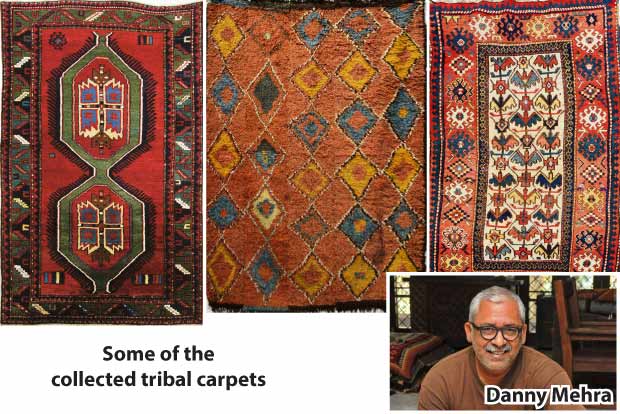Begin typing your search...
Collecting stories woven in carpets by tribal communities
Danny Mehra has a hobby unlike any other — gathering carpets woven by women belonging to nomadic tribes and villages along the erstwhile Silk Route across nations. The one-of-a-kind collector will soon be showcasing the rare rugs in city.

Chennai
It was two carpets he had received as his wedding gift from his mother-in-law way back in the early 1980s that ignited Danny Mehra’s appreciation for rugs. “It’s a pretty mad hobby, you know? I’ve always had the collecting gene and collected tribal furniture at one point. After my mother-in-law gave us these two carpets, it sowed the seeds in me to start collecting old tribal rugs. I grew keen to collect rugs from the old Silk Route.
Through auctions and other collectors, I was gathering carpets that were handwoven by women of nomadic tribes across the countries along the Silk Route like China, Kazakhstan, Tajikistan, Uzbekistan, Turkmenistan, Iran, Azerbaijan, Armenia, Syria and Turkey,” recalls Danny speaking to DT Next.
What makes these carpets so special, we ask him. “Tribal women in these countries had once woven these carpets as a hobby, between their daily chores. These designs weren’t drawn on paper, but woven directly from their imagination. Since they lived in tents and small homes, being nomads, the women worked on horizontal makeshift looms to create these carpets.
Whenever the weather would get cold, they would move in search of warmer weather, so that their livestock could find grass. Their weaves contain many nuances of their lives and what they saw around them,” elaborates the 62-year-old, who has been collecting these rare carpets for the past 30 years.
The carpets, made from wool sourced from the animals raised by the tribal people, include elements from nature like birds, flowers, mountains, rivers, animals and people, notes Danny. “I think their weavings are perfectly imperfect.
They are made with a lot of spontaneity, which always puts a smile on people’s faces when they see these rugs for the first time. The carpets were also multi-functional for the tribal people, as they were used on the floor, as bed spreads and were also hung on the walls,” he adds. With socio-political changes in these countries along the erstwhile Silk Route, these weaving traditions remain long gone, says Danny.
How many rugs has he managed to accumulate over these years? “Enough to cover a whole football field. And enough to lay upon the tallest building in the world, Burj Khalifa, and still have some more left,” he admits, laughing. “I have stopped keeping a count, but a large section of our Bengaluru home is now dedicated to the carpets alone,” adds Danny.
This unique hobby makes Danny one among a tiny community of rare carpet collectors around the world. “What I’m looking for is carpets made by women who found joy in their weaving, and their weaves telling stories of their daily life,” reiterates the collector, who earlier worked on the Wall Street in New York. “I chose to retire early as I enjoy meeting creative people and collecting the rugs. But, I wouldn’t know when I would find my next carpet,” he admits.
Over the next decade, Danny hopes to have the collected carpets in homes across India. “I may also consider having them exhibited in a museum,” he adds. The carpets from ancient Silk Road will be displayed from January 31 to February 2 at Amethyst, Royapettah.
Visit news.dtnext.in to explore our interactive epaper!
Download the DT Next app for more exciting features!
Click here for iOS
Click here for Android
Next Story



